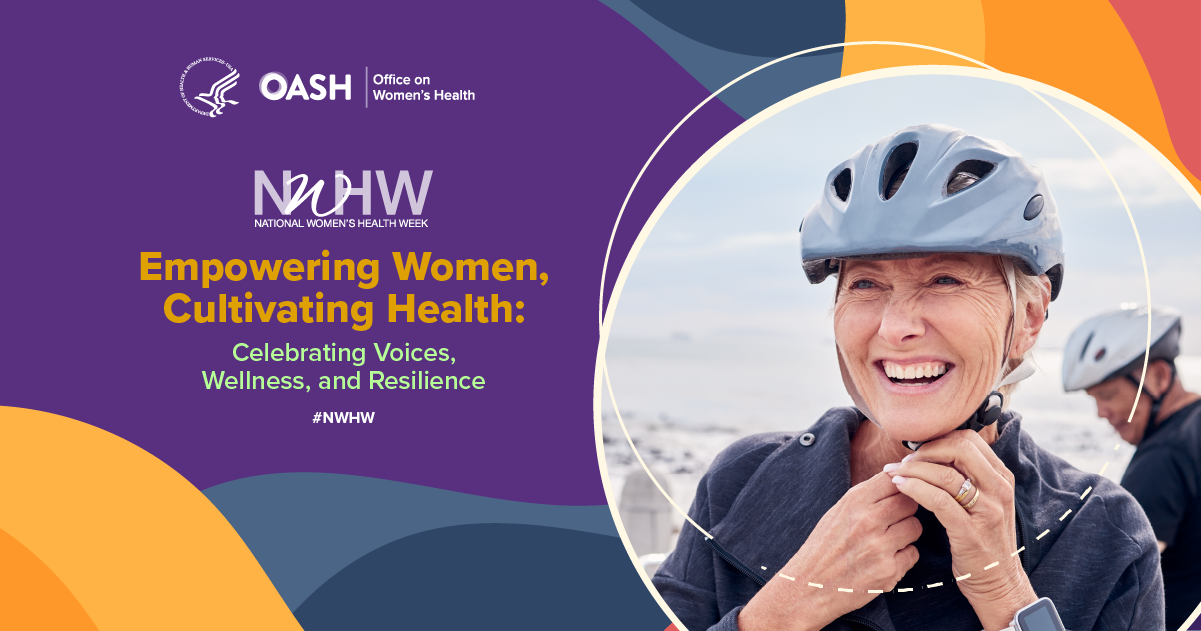Day 7 - May 18: Women and Heart Health

Understanding Women’s Heart Health: Pregnancy, Stress, and Hormones
Heart disease isn’t just a health issue; it’s the leading cause of death for women. However, research has shown that only about half (56%) of women living in the U.S. recognize that heart disease is their number 1 killer. Heart health is a critical concern for women of every age and background, and the risks for heart disease vary widely from person to person. Heart disease affects women of color at higher rates compared to their White counterparts, with Black women facing the highest risk of any group of women and Hispanic women often experiencing heart-related problems earlier in life.
Women’s heart health needs differ from men’s, and factors such as pregnancy, the stress of daily life, and the natural changes in hormones over time influence them. These elements play significant roles in a woman’s heart health.
 Share our Women’s Heart Health social media graphics with your network to highlight heart health considerations unique to women.
Share our Women’s Heart Health social media graphics with your network to highlight heart health considerations unique to women.
The Impact of Pregnancy
Pregnancy is a demanding time for the body. It can reveal or exacerbate existing heart conditions or increase the risk of developing new ones, such as hypertension (high blood pressure), gestational diabetes, preeclampsia, and eclampsia. These conditions not only affect women during pregnancy but can also have long-term effects on heart health. Post-pregnancy, it’s important for women to monitor their heart health closely and get regular checkups.
Chronic Stress: A Silent Threat
Women often juggle multiple roles, leading to increased levels of chronic stress. This constant pressure can lead to high blood pressure, higher cholesterol levels, and even an increased risk of coronary artery disease. Finding healthy ways to manage stress, such as exercise, meditation, and talking to a mental health professional, is vital for heart health.

Hormones and Heart Health
Hormonal changes throughout a woman’s life, including those during menstruation, pregnancy, and menopause, can affect heart health. For instance, the drop in estrogen levels during menopause can increase the risk of developing heart disease. Being aware of these changes and how they can affect your heart is essential in taking charge of your health.
Understanding Risk Factors
- High Blood Pressure: This is a major risk factor for both heart disease and stroke. It’s often called the “silent killer” because it often doesn’t have any symptoms.
- High Cholesterol: This can lead to the buildup of plaque in arteries, increasing the risk of heart attack and stroke.
- Smoking: Smoking damages nearly every part of the body, including the heart and lungs, significantly increasing the risk of heart disease.
- Diabetes: Compared to men with diabetes, women with diabetes have twice the risk of heart disease.
- Obesity: Excess weight increases stress on the heart, leading to a higher risk of heart disease.
- Poor Diet: Diets high in trans fats, saturated fats, sodium, and sugar can raise risk factors for heart disease and stroke.
- Physical Inactivity: A sedentary lifestyle, or minimal physical activity throughout the day, is one of the top risk factors for heart disease.
- Excessive Alcohol Use: Drinking too much alcohol can lead to increased blood pressure, heart failure, and stroke.
- Stress: Long-term stress leads to higher heart rates and blood pressure, indirectly increasing the risk of heart disease.
- Sleep Apnea: Sleep apnea, when breathing stops and starts repeatedly throughout the night, often goes undiagnosed and can lead to sudden cardiac death.
- Inflammatory Diseases: Conditions such as rheumatoid arthritis, lupus, and psoriasis can increase the risk of heart disease.
- Family History: A family history of heart disease among relatives closest to you, like your parents or siblings, increases your risk.
- Age: Heart disease risk increases for women over 55.
- Race and Ethnicity: People of certain races and ethnicities, including Black and Hispanic communities, have a higher risk of heart disease.
Recognizing a Heart Attack in Women
Heart attack symptoms can be different in women than in men. Although chest pain is common for both, women are more likely to experience other symptoms, such as:
- Shortness of breath
- Nausea or vomiting
- Back or jaw pain
- Unexplained fatigue
- Dizziness or lightheadedness
These symptoms can be subtle and are sometimes dismissed as being related to stress or anxiety. If you experience these signs, seek medical attention immediately.

Knowledge is power, including when it comes to your heart health. By understanding the different heart disease risk factors for women and the different signs of heart issues in women, you can take proactive steps to protect your heart and live a healthier life.
Prevention Is Possible
Up to 80% of heart attacks and strokes can be prevented. How? It starts with lifestyle changes. This means eating a balanced diet filled with fruits, vegetables, and whole grains, engaging in regular physical activity (at least 150 minutes of moderate exercise per week), quitting smoking, and managing stress. It’s also important to be proactive about your health by getting regular checkups to monitor blood pressure, cholesterol levels, and other heart disease indicators. Education plays a crucial role because understanding the risk factors and how to address them can drastically reduce the likelihood of heart disease and stroke.
Awareness and Action
Heart disease can be a silent threat to women as many are unaware of their heart disease risk. This gap in awareness means many women may not take the necessary steps to prevent heart disease until it’s too late. Spreading the word, sharing resources, and encouraging women to take action for their heart health is vital to better health outcomes. Knowing the signs of heart disease and stroke, understanding the risk factors, and taking proactive steps toward a healthier lifestyle can make all the difference.
Resources to Learn More
- 5 things women should ask their OB-GYN about their heart. Yes, the heart. - American Heart Association
- ABCS of Heart Health - Million Hearts®
- Heart Health for Women - U.S. Food & Drug Administration’s Office of Women’s Health
- Heart Smart Basics: What to Know to Keep Yours Healthy Fact Sheet - NIH National Heart, Lung, and Blood Institute
- Listen to Your Heart: Women and Heart Disease - NIH National Heart, Lung, and Blood Institute
- Move Your Way® During and After Pregnancy - HHS Office of Disease Prevention and Health Promotion
- Preeclampsia and Eclampsia Resources - Eunice Kennedy Shriver National Institute of Child Health and Human Development
- Pregnancy and Your Heart Health Fact Sheet - NIH National Heart, Lung, and Blood Institute
- Questions to Ask About Your Blood Pressure Fact Sheet - NIH National Heart, Lung, and Blood Institute
- Take Action for Your Heart: Get Started! Fact Sheet - NIH National Heart, Lung, and Blood Institute
- The TRUTH About Women and Heart Disease Fact Sheet - NIH National Heart, Lung, and Blood Institute
- Yes, YOU: The Truth About Women & Heart Disease Video - NIH National Heart, Lung, and Blood Institute
- You can prevent heart disease. Yes, YOU! – NIH National Heart, Lung, and Blood Institute


